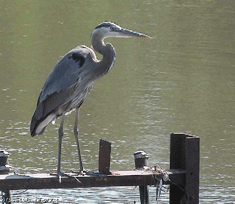
Great Blue Heron (Photo: Gene McDaniel, Raytown)
Great Blue Heron (Photo: Gene McDaniel, Raytown)
Commentator Tom Montgomery-Fate writes about the return of the great blue heron to his farm in Michigan.
CURWOOD: “Wilderness” is not a term usually associated with the farmland and woodlots of the Midwest. Yet, commentator Tom Montgomery-Fate sees some wild hope in the return of Great Blue Herons to his farm in Michigan.
MONTGOMERY-FATE: Recently five pairs of great blue herons flapped back to our small farm in southwest Michigan to lay their eggs. Each spring they have returned in their gangly grace to patch and repair the great prickly bowls of sticks they first built four years ago. The now sturdy nests are about three feet across and sit 80 or 90 feet off the ground near the tops of two Sycamore trees. The trees drape over a small, polluted river which runs in to Lake Michigan.
Our land, like much of the central Midwest, has been harmed by agriculture, industry, and new development. Million dollar vacation homes have started popping up just down the road. The animals that thrive here are tough, raccoons and possums and coyotes, starlings and grackles and turkey vultures, species that quickly adapted to the ravaged habitat, to pesticides and herbicides, and the river that absorbed them.

Great Blue Heron (Photo: Gene McDaniel, Raytown)
If all these herons can find the frogs and fish they need to feed their fledglings, this is a good sign. Maybe the ongoing efforts to clean up the river and stave off soil erosion are actually helping.
This morning as I tramp through the woods I can hear the herons low grumbling when I’m still a quarter mile away—auditory bread crumbs leading me through the wild rose brambles and deadfalls. Their rough, low voices seem to tease me with a question: “What, What, What, What are you doing?”
“I’m watching,” I say aloud to myself, “just watching.” I lay flat on my back underneath the old sycamore with my binoculars aimed at the nests. One bird gets anxious, peers at me with a haunting yellow-ringed eye, and makes his decision. He stumbles around in the sticks, unfolds that great prehistoric S of a body and tumbles into the air with an awkward beauty that seems to fit these woods, this recovering bit of land in the non-wilds of the Midwest.
CURWOOD: Tom Montgomery-Fate teaches writing at College of DuPage in Glen Ellyn, Illinois, and is the author of a new memoir, “Steady and Trembling.”